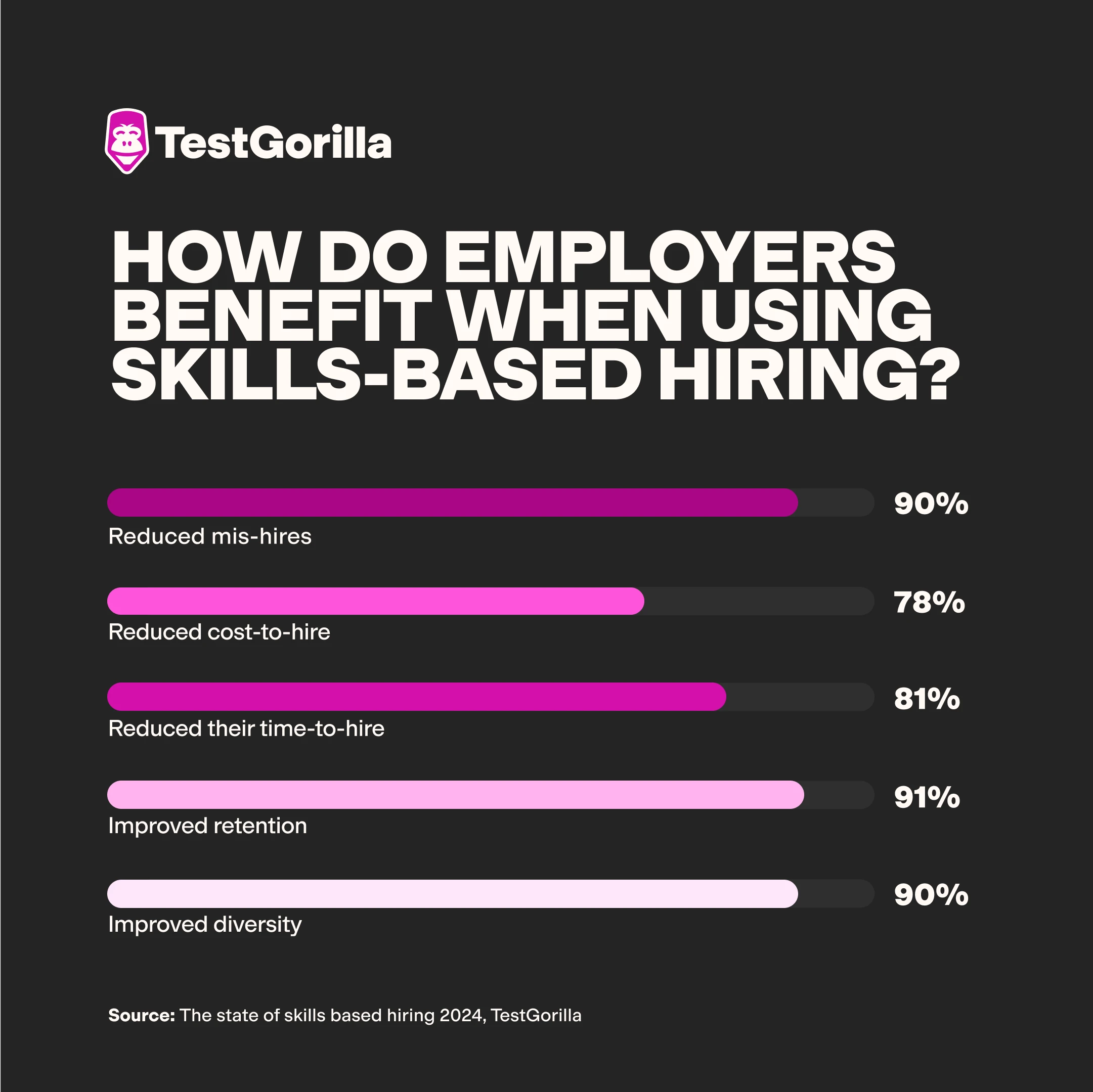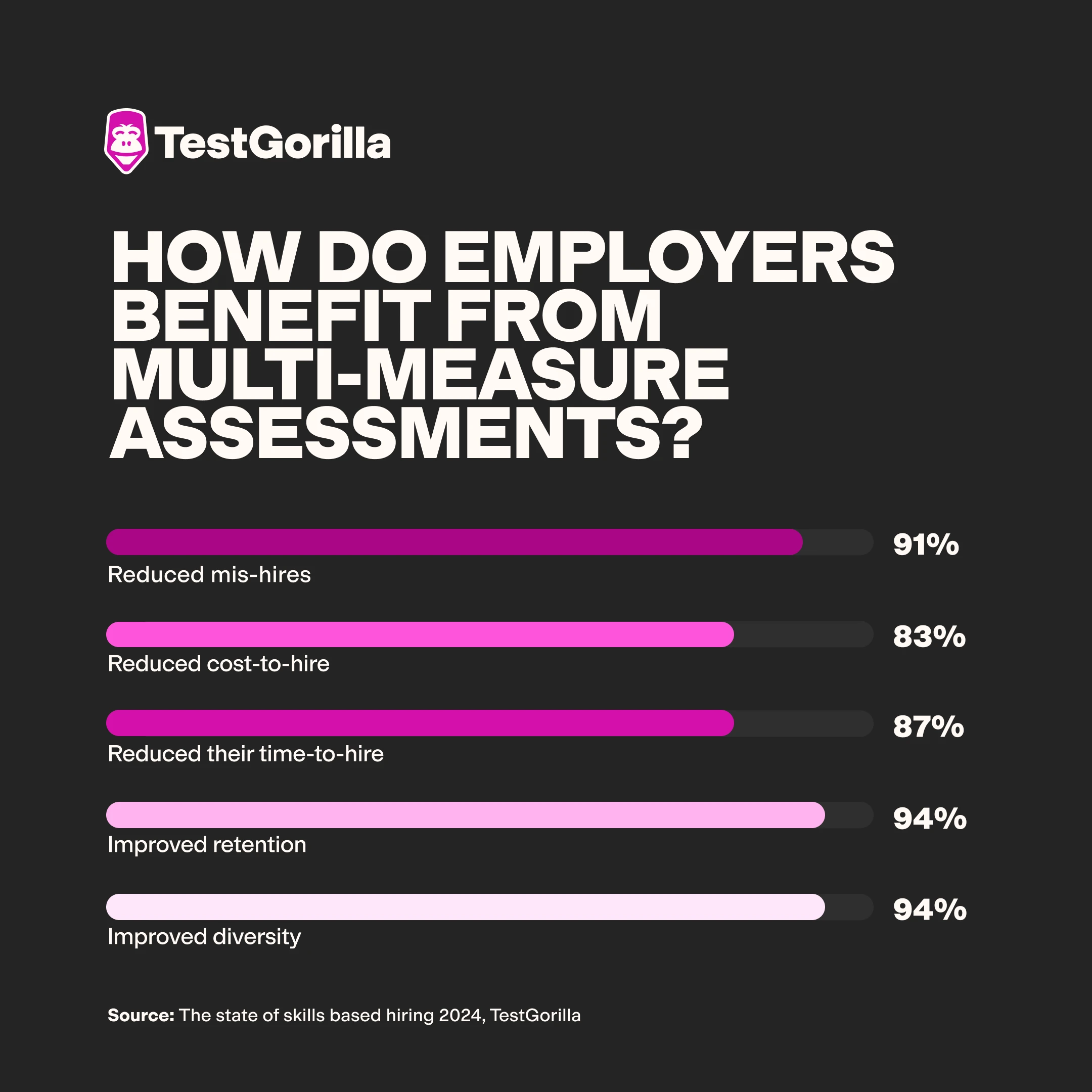What is job relatedness and how can you use it to create better skills assessments?
Job-relatedness is a key concept in recruiting. It looks at whether the requirements (AKA “criteria”) of a job – including skills and qualifications – are related or relevant enough to the job to justify the company requiring them.
This concept is important to various aspects of hiring – where your job requirements inform everything from your recruitment materials to your candidate assessments.
Table of contents
Job-relatedness examples
Example | Level of job-relatedness | Why? |
A junior software developer job description includes “strong leadership skills” as a requirement | ❌ Low job-relatedness | Since this isn’t a leadership position, strong leadership skills aren’t directly related to the job |
A customer service interview asks “What’s your favorite hobby?” | ❌ Low job-relatedness | The candidate’s favorite hobby has nothing to do with the customer service gig |
An advanced Microsoft Excel assessment asks questions about Excel features, functions, and formulas | ✅ High job-relatedness | These questions are directly relevant to the job |
Common features of job-relatedness
Hiring processes with strong job-relatedness typically share these common features.
Direct link to job performance and business necessity: In hiring processes with high job relatedness, job descriptions, assessments, and other materials and tools are directly tied to the specific responsibilities of the role and the essential needs of the business.
Fairness and legal compliance: Job-relatedness keeps the hiring process fair and compliant – especially with employment laws.
Measurability and predictiveness of on-the-job success: Hiring tools with high job-relatedness offer clear criteria for judging candidates – and they’re good indicators of how well someone will perform in the job.
What are the benefits of job-relatedness?
Here are three big reasons to care about job-relatedness.
Improved hiring accuracy
Hiring tools that have high job-relatedness directly target the skills that predict job success, so they’ll help you find candidates most likely to succeed.
For instance, job-related assessments lead to more precise hiring outcomes because they focus on specific, role-based competencies – so candidates who score high on these assessments will perform better than those who score low. Once hired, these candidates typically are happier in their roles and less likely to leave.
Don’t believe it? Here’s some proof. In our 2024 annual report, we surveyed employers who use skills-based hiring (meaning: they look for candidates with job-related skills, measuring candidates based on these skills). We discovered that they experienced the following benefits:
90% reduced their mis-hires
78% reduced their cost-to-hire
81% reduced their time-to-hire
91% improved retention
90% improved diversity
Meanwhile, employees who looked at multiple job-relevant “measures” (for example, job-related technical skills, soft skills, situational judgment, language proficiency, and more) experienced these benefits:
91% reduced their mis-hires
83% reduced their cost-to-hire
87% reduced their time-to-hire
94% improved retention
94% improved diversity
Reduced legal risks
Hiring tools and criteria with high job-relatedness are key in neutral employment practices: practices designed to avoid employment discrimination and keep your hiring practices and employment decisions fair. These help you comply with legislation like the Americans with Disabilities Act (ADA) and Title VII of the Civil Rights Act – which make it illegal to unfairly disadvantage individuals with disabilities and other protected groups.
Hiring materials and tools that aren’t related to job requirements can be challenged as discriminatory – a compliance officer’s nightmare.
For example, discriminatory employment tests will measure candidates on areas not essential to the job – and in the process, they’ll discriminate against certain groups of candidates. For example, a clerical employment test might ask, “Can you lift 50 lbs?” This could discriminate against candidates with physical disabilities – especially if the role doesn't typically involve manual labor and these candidates could perform the essential functions of the job just fine.
The reverse is true: Legally defensible hiring processes help you justify your employment actions – like dismissing a candidate because they don’t have the skills you need.
Say you use assessments with high job-relatedness to select the best candidate for your role – for instance, a typing skills test for a clerical role. In the event of a legal challenge based on national origin, age in employment, disability, or something else, you can show that job-related testing is a business necessity.
For recruitment managers focused on diversity, equity, and inclusion (DE&I), a hiring process with built-in job-relatedness also helps foster a culture of fairness.
Streamlined recruitment process
Job-related criteria and tools help streamline the recruitment process, saving time and improving the whole hiring process. By focusing on key competencies that matter for the role, recruitment managers can quickly identify the best candidates – upping candidate quality while keeping time-to-hire low.
This is especially important for growing startups that need to scale quickly while maintaining high standards of accuracy and performance.
🔎Learn more about the legal defensibility of TestGorilla’s assessments, concepts related to job-relatedness (like predictor-criterion congruence), and so much more on TestGorilla’s blog.
FAQs
1. What is the meaning of job-related criteria?
Any criteria – or job requirements – used during the hiring process or employee performance appraisals must follow the rule of job-relatedness. They must determine and measure skills and other qualities that are directly related to successful job performance and necessary for the business’s operations and success.
2. Why should managers consider the role of job-relatedness in employment?
Managers must make sure their recruitment materials, tools, and processes are job related to improve hiring accuracy, reduce legal risk, and streamline the recruitment process. They must also consider job-relatedness in performance management – they must evaluate and develop their current employees using job-related criteria.
3. What is a job-related factor?
Job-related factors are anything in the design or management of the workplace and job tasks that can positively or negatively impact an employee’s mental health, engagement, performance, and more. For example, a noisy work environment can make focusing difficult. Employers can make reasonable accommodations – adjustments to work environments or duties – to help employees (especially those with disabilities) manage their well-being and productivity.
Related posts
You've scrolled this far
Why not try TestGorilla for free, and see what happens when you put skills first.
Latest posts
The best insights on HR and recruitment, delivered to your inbox.
Biweekly updates. No spam. Unsubscribe any time.

Skills tests to hire the best
Our screening tests identify the best candidates and make your hiring decisions faster, easier, and bias-free.
Free resources
A step-by-step blueprint that will help you maximize the benefits of skills-based hiring from faster time-to-hire to improved employee retention.
With our onboarding email templates, you'll reduce first-day jitters, boost confidence, and create a seamless experience for your new hires.
This handbook provides actionable insights, use cases, data, and tools to help you implement skills-based hiring for optimal success
A comprehensive guide packed with detailed strategies, timelines, and best practices — to help you build a seamless onboarding plan.
This in-depth guide includes tools, metrics, and a step-by-step plan for tracking and boosting your recruitment ROI.
Get all the essentials of HR in one place! This cheat sheet covers KPIs, roles, talent acquisition, compliance, performance management, and more to boost your HR expertise.
Onboarding employees can be a challenge. This checklist provides detailed best practices broken down by days, weeks, and months after joining.
Track all the critical calculations that contribute to your recruitment process and find out how to optimize them with this cheat sheet.
















